Loblolly Pine: Cones, Needles, Bark (With Pictures) – Identification and Care

The loblolly pine tree is a tall evergreen conifer with needle leaves, small yellow or purple flowers, and rusty-brown conical pine cones. Loblolly pine trees are native to the Southeastern United States, where they are one of the most common pine trees. The fast-growing pines are popular for planting as an evergreen screen in garden landscapes. In their native habitat, the attractive loblolly pine tree grows up to 115 ft. (35 m) tall and has a recognizable dense oval crown.
Many types of pine trees are suited to hot and temperate climates. This article examines the features of an evergreen coniferous tree that thrives in hot summers and cool winters — the loblolly pine.
Descriptions and pictures of loblolly pine tree needles, cones, bark, and flowers will help you identify this tall evergreen. In addition, you will find helpful tips on growing loblolly pine in a garden landscape.
Loblolly Pine (Pinus taeda) Facts
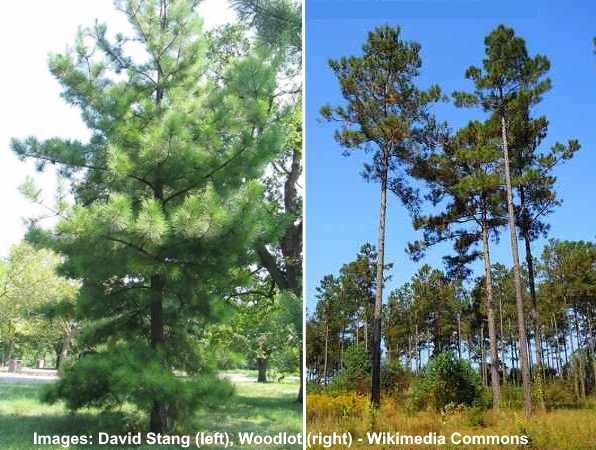
Young and mature loblolly pine (Pinus taeda)
The loblolly pine is a tall conifer in the genus Pinus and the family Pinaceae. The evergreen loblolly pine is identified by its oval-rounded crown, dark green needle leaves, and long cylindrical green cones that mature to buff-brown.
Loblolly pines grow 40 to 115 ft. (12 – 35 m) tall and up to 40 ft. (12 m) wide. In cultivation, the loblolly pine typically grows between 40 and 50 ft. (12 – 15 m) tall. Therefore, the evergreen tree is suitable for extensive gardens.
The dwarf loblolly pine tree (Pinus taeda ‘Nana’) is more popular for landscaping. With the correct pruning, the dwarf evergreen tree grows as an evergreen hedge, screen, or natural fence.
The ideal USDA growing zone for the loblolly pine tree is 6 to 9, where it will perform well in acidic or alkaline soils. In addition, the loblolly pine is well-suited to its native environment. It has rapid growth in full sun, hot and humid summers, and grows in moist, poorly-draining soils.
According to some data, the loblolly pine tree is one of the most common native trees in the US. The loblolly pine tree is common in Florida, Texas, and as far north as New Jersey.
The loblolly pine is grown for its quality timber. The fact that the loblolly pine is the fastest-growing Pinus makes it commercially important. It grows at more than two feet (60 cm) per year.
The common name of loblolly means mudhole. This refers to the tree’s growth habits, where it thrives in swampy, marshy areas. Pinus taeda also goes by the names of rosemary pine, oldfield pine, and bull pine. The name rosemary pine comes from its aromatic twigs and leaves.
Loblolly Pine Needles (Leaves)
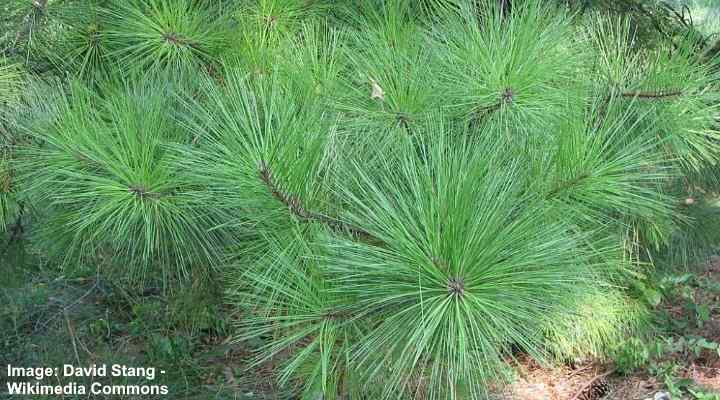
Loblolly pine needles
The green needles on loblolly pine trees grow on aromatic twigs in bundles of three. The long slender needle leaves measure 5” to 10” (13 – 25 cm) long. The loblolly pine needles are described as stiff and thin with finely-toothed margins. The needles are shed every three years.
Loblolly Pine Cones

Loblolly pine female cones at different stages of maturity
Cones growing on the loblolly pine tree are identified as reddish-brown and have a narrow, conical shape. The pointed, egg-shaped loblolly pine cones have sharply spined scales that open wide in dry weather. The conical rusty-brown cones are stalkless and grow 3” to 6” (7.5 – 15 cm) long.
A feature of loblolly pine cones is that the spines are so sharp that they can pierce the skin if you squeeze them tightly.
Loblolly Pine Bark
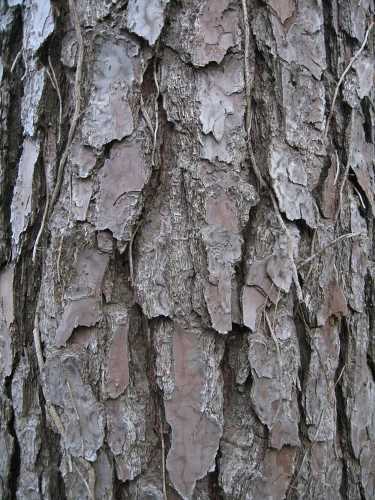
Loblolly pine bark
Scaly gray bark is a recognizable feature of loblolly pine trees. The thick bark develops deep fissures and has a reddish-brown color as the tree matures. The irregularly shaped, peeling scales give the pine tree’s straight trunk a rough texture. In addition, the thick bark provides the tree with excellent fire-resistant properties.
An identifying feature of the loblolly pine in southern landscapes is its straight trunk that is branchless to the crown. As the tree matures, it loses its lower branches. The branches in the crown are spreading and ascending, giving the pine tree a rounded, pyramidal appearance at the top.
Loblolly Pine Twigs
Loblolly twigs are slender with an orangey to yellow-brown color. The twigs become darker brown and rougher as the loblolly tree ages. The pine tree twigs are relatively brittle and are susceptible to breakage. Needle leaves grow in bundles of three, and the tufts of needles grow at the apex.
Loblolly Pine Flower
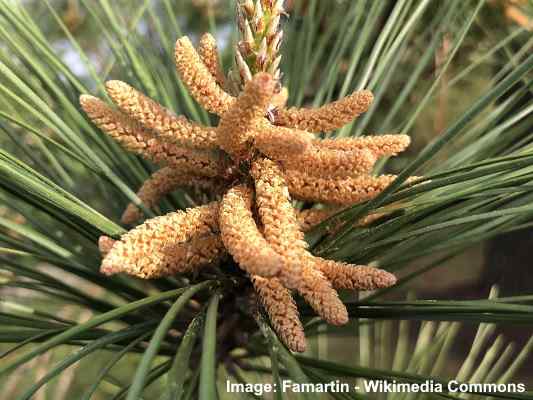
Loblolly pine male pollen cones
The flowers on a loblolly pine tree are orangey or yellow male pollen cones that look like clusters of catkins. The pollen-producing male flowers appear in March and April. Loblolly pine trees are monoecious — meaning they produce male and female flowers on the same tree. The female “flowers” develop into pine cones.
Loblolly Pine Identification
A loblolly pine tree is identified by its straight trunk covered in a scaly, reddish-brown to gray bark. Mature loblolly trees are branchless to the oval, conical crown. Rusty-brown, long, cylindrical seed cones with stout triangular scales also help identify the loblolly pine tree. Also, the needles grow in bundles of three.
Longleaf Pine vs. Loblolly Pine
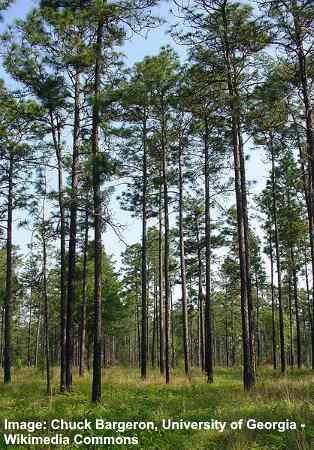
Longleaf pine trees (Pinus palustris)
Loblolly pine trees and longleaf pines (Pinus palustris) are native to the Southeastern US and can be challenging to tell apart. The differences between the two pine species are the needle length, growth habit, and bark color.
Compared to the longleaf pine, the loblolly pine has shorter needles and smaller pine cones. In addition, loblolly pines have faster growth, especially when young — although both species mature at a similar height. Loblolly pines are easy to identify in a landscape because they usually lose their lower branches.
Loblolly Pine Tree Landscape Uses
Loblolly pine trees are not the most popular ornamental pines for a garden landscape. However, they are valuable pines in a southern landscape. They thrive in environments where other pines perform poorly. Due to their rapid growth, loblolly pine trees are popular for growing a fast screen.
Where to Plant Loblolly Pine Tree
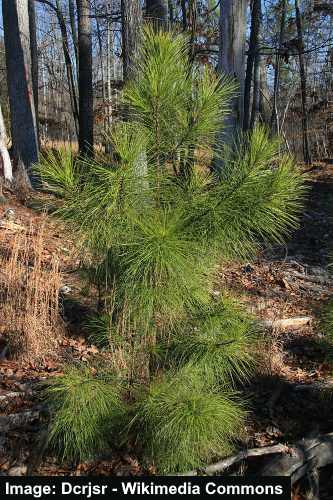
A young loblolly pine tree
When deciding where to plant a loblolly pine tree, you should choose a location with full sun. The planting site should be well-drained. However, these drought-tolerant pine trees can also grow in moist or poorly-drained soil. In its native environment, it will perform well in swampy ground.
Many homeowners plant loblolly trees as a fast growing, evergreen screen. However, if you plan to grow a specimen tree, it is good to think about its mature height and spread. In residential settings, the fast-growing tree can grow around 50 ft. (15 m); however, they can reach 100 ft. (30 m) in the wild.
When growing a loblolly pine, the good news is that it won’t take much maintenance. The evergreen tree adapts well to most sites and soils. The only issue with the location can be if the soil is very infertile and continually wet.
How to Plant a Loblolly Pine Tree
Planting a loblolly pine tree is straightforward. First, dig a hole about three times the width and the same depth as the root ball. Before planting the rooted nursery pine tree, remove any burlap wrap and untangle roots. Then, place the loblolly tree in the hole and backfill with native soil amended with compost, ensuring the tree grows at the same height as before.
As you fill the soil in the hole, press it down with the spade to remove any air pockets. When the hole is filled, thoroughly water the pine tree’s roots. This will help settle the tree and give the roots a good start. Lastly, add a 3” (7.5 cm) layer of mulch around the root area.
The best time to plant a loblolly pine tree in the ground is in early spring.
Loblolly Pine Tree Care Guide
Loblolly pine trees are ideal for landscapes where other trees can’t survive. The dense foliage provides all-year color, and the fast-growing evergreen makes for a perfect privacy screen. To care for the pine tree, all it needs is occasional watering and fertilizing every two to three years.
How to Water Loblolly Pine Tree
It would be best to water a loblolly pine tree during hot, dry seasons. The best way to irrigate the roots is to provide a trickle of water over the root area for around an hour. This should soak the ground up to 8” (20 cm) deep.
Deep watering encourages healthy root growth and keeps the pine tree resistant to disease.
Regularly watering a loblolly pine tree is vital after planting the tree. An immature pine needs watering every seven days during the first season. This is necessary to help the roots get established in the ground.
Loblolly Pine Tree Fertilization
Loblolly pine trees have few fertilization requirements. Typically, you can apply a balanced tree fertilizer every two to three years in early spring. However, it’s best to choose a fertilizer for evergreen shrubs and trees. For example, a fertilizer with an NPK rating of 10-10-10 is ideal for loblolly pine.
To fertilize a loblolly tree, choose a granulated, slow-release application. Follow the manufacturer’s instructions as to the amount of fertilizer to apply. Ensure that the root area receives an even amount of granules. Then water the ground thoroughly to allow the fertilizer to penetrate to the roots.
Loblolly Pine Tree Pruning
It is generally advisable not to prune a loblolly pine tree unless you are removing dead, diseased, or decaying branches. However, suppose you need a low-growing pine tree or large evergreen shrub. In that case, it’s best to look for a dwarf variety of loblolly pine trees or choose a different type of evergreen tree.
Loblolly Pine Tree Propagation
Loblolly pine trees can grow from seeds by harvesting the seeds in the fall. However, to increase the chances of germination, it’s vital to stratify the seeds by ensuring they are exposed to cool temperatures. After that, you can germinate the pine seeds in individual pots before transferring them to the garden.
To grow a loblolly pine from seed, collect plenty of seeds. The seeds look like tiny brown, winged structures. You should soak the seeds in warm water for 24 hours. Next, discard any seeds that float and remove the pine nuts from the papery casing.
Place the seeds in a sealable plastic bag half-filled with moist sand and store in the refrigerator at 35°F to 40°F (1.6°C – 4.4°C) for 60 to 90 days. It’s vital to keep the sand moist so that the seeds don’t dry out.
The next stage is to plant individual pine seeds in small pots containing a moist, acidic potting mix. To sprout pine seeds, push them into the soil with the pointed end facing downward. Then cover the pots with plastic and place them on a sunny windowsill and keep the potting mix moist. It will take a few months for pine trees to sprout.
The pine tree seedlings are ready for planting in the ground when they are 6” to 12” (15 – 30 cm) tall.
Pests Affecting Loblolly Pine Tree Growth
The loblolly pine tree is susceptible to certain pests that affect southern pine trees. Typically, healthy trees growing in the right conditions are relatively unaffected. Healthy pine trees produce a resinous sap to kill off pests. However, pine beetles, weevils, and moth larvae can affect the pine tree’s growth.
Southern Pine Beetles (Dendroctonus frontalis): This brownish-black bark beetle is a destructive pest that attacks loblolly pine, shortleaf pine, and Virginia pine trees. The small brown beetle measures about 0.12” (3 mm) long — about the size of a grain of rice. A severe infestation can cause a pine tree to die.
The first sign of southern pine beetles is resinous masses on the tree’s bark. The best way to prevent beetle damage is to maintain the tree’s health by watering it regularly during dry conditions. It’s also a good idea to only prune a loblolly tree in winter when beetle activity is minimal.
Pales weevils (Hylobius pales): Another serious pine tree pest is the pales weevil. This small brown beetle usually attacks loblolly pine tree seedlings or young trees. The small weevil measures 1.2” (1 cm) long, and its larva is a C-shaped, creamy white grub. You may notice resin blobs on the tree bark if there is a weevil or beetle infestation.
Nantucket pine tip moth (Rhyacionia frustrana): Loblolly pine trees are susceptible to twig and foliage damage by the Nantucket pine tip moth. The moth larvae feed on the needle leaves of young pine trees, typically under five years old. Damage can result in stunting and stem deformation.
Diseases Affecting Loblolly Pine Tree Growth
Like most southern pine tree species, the loblolly pine tree is relatively disease-resistant when grown in ideal conditions. However, high humidity, overly-wet ground, and weather conditions can result in foliar, fungal, and bacterial diseases.
Fusiform rust / pine-oak rust (Cronartium quercuum): This foliar disease can cause unsightly brown patches on the dark green needle leaves of loblolly pine trees. This disease can also cause galls to form on pine saplings and lead to the eventual death of the tree.
Root rot (Heterobasidion annosum): Loblolly pine trees that grow on sandy, well-drained sites can be affected by root rot. The disease usually occurs when fungi enter the tree after pruning or thinning the tree. The infection spreads to the roots and then affects the tree’s growth.
Loblolly Pine Distribution
Loblolly pine trees are found throughout the Southeastern United States. The tree’s natural habitat is from southern New Jersey to central Florida and west to eastern Texas. You will also find the loblolly pine tree growing in the wild in the Atlantic Coastal Plain and the Appalachian mountains.
Related articles:
